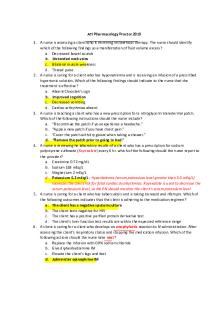Pharm - ATI Nutrition for Nurses - Ch 10 TPN PDF

| Title | Pharm - ATI Nutrition for Nurses - Ch 10 TPN |
|---|---|
| Author | Olga La belle |
| Course | Pharmacology |
| Institution | Rutgers University |
| Pages | 2 |
| File Size | 69.1 KB |
| File Type | |
| Total Downloads | 101 |
| Total Views | 148 |
Summary
Pharmacology: TPN Nutrition and detail classification, side effects. Patient monitoring, signs, and symptoms. Nursing assessment for hypoglycemia...
Description
ATI Nutrition for Nurses – Study Guide Chapter 10: Total Parenteral Nutrition What is Total Parenteral Nutrion (TPN)? And PPN? TPN is used when a client’s gastrointestinal tract is not functioning, or when a client cannot physically or psychologically consume sufficient nutrients orally or enterally. TPN provides a nutritionally complete solution. It can be used when caloric needs are very high, when long term therapy is indicated, or when the solution to be administered is hypertonic (composed of greater than 10% dextrose). It can only be administered in a central vein. PPN is peripheral parenteral nutrition administered for up to 14 days into a peripheral vein. It is nutritionally incomplete because it has a low dextrose content. It is indicated for clients who required short term nutritional support with fewer calories per day. The solution must be isotonic and contain no more than 10% dextrose and 5% amino acids. What are the primary components of TPN? 1. 2. 3. 4. 5.
Carbohydrate or dextrose Electrolytes, Vitamins, and trace elements Lipids Fats Protein Other substance such as Insulin for hyperglycemia, heparin to prevent fibrin building on the catheter tip, glutamine, antioxidants, prebiotics, or probiotics prescribed based on individual needs
What is the purpose/ indication? Give a few examples of patients who need TPN.
Used in clients who need intense nutritional support for extended period of time. Clients undergoing treatment for cancer, bowel disorders, critically ill, trauma, and extensive burns.
How do we know TPN is effective? (What are the desired therapeutic outcomes?)
Improved nutritional status Weight maintenance or gain Positive nitrogen balance
What are some complications of using TPN?
Infection and sepsis (fever or elevated WBC count due to contamination of the catheter during insertion, solution, or long-term indwelling catheter) Metabolic complication (hyperglycemia, hypoglycemia, hyperkalemia, hypophosphatemia, hypocalcemia, dehydration (related to hyperosmolar diuresis resulting from hyperglycemia) and fluid overload.
Mechanical complication: catheter misplacement resulting in pneumothorax or hemothorax (evidenced by SOB, diminished or absent breath sounds), arterial puncture, catheter embolus, air embolus, thrombosis, obstruction, and bolus infusion due to incorrectly set or malfunctioning electronic pumps. Refeeding syndrome occur when the body rapidly changes form catabolic (seen in starvation states) to anabolic metabolic when nutrition started.
What is the focus of Nursing Care, when caring for a patient on TPN? 1. Preparation (a few important points) Use strict aseptic technique when setting up IV tubing, change the site dressing Change PN bag and tubing set Q24 hr or per facility protocol, Monitor s/s of infection 2. Ongoing care and nursing actions (summarize a few highlights) Monitor flow rate carefully (Do not attempt to increase the rate of the PN solution to catch up. To avoid hypoglycemia, an IV of dextrose 10% to 20% in water is administered if the PN solution is unavailable. Monitor for cracking of TPN solution has oily appearance or a layer of fat on top of the solution and should not be used. Verify the prescription of the PN solution with a second nurse prior to administration. If PN solution is prepared and stored in the refrigerator, allow it to come to room temperature for 1hr prior to administering it. Maintain strict aseptic techniques to reduce the risk of infection Use sterile technique when changing central line dressing and tubbing. Change the bag and IV tubing for the dextrose solution Q24 hr unless facility policy differs. With intermittent IV lipid infusions, ensure the solution does not hang more than 12 hr to prevent microbial growth. Ensure lipid infusion is stopped 12 hr prior to obtaining a blood specimen for triglycerides to ensure accurate results...
Similar Free PDFs

TB Nutrition CH 10
- 14 Pages

Pham ATI Proc - Pharm for ATI
- 10 Pages

ATI-pharm-immune - ati
- 3 Pages

ATI Book: Nutrition for Nursing
- 119 Pages

ATI-drugs - ATI pharm Prep
- 20 Pages

ATI 2019 Pharm Predictor
- 20 Pages

ATI Pharm Questions 1
- 21 Pages

Pharm-ATI Proctored Exam
- 20 Pages

Dosage Calculations for Nurses
- 8 Pages

Microbiology for Nurses 3053
- 103 Pages

Nutrition ATI formatted
- 25 Pages

Nutrition ATI 83 Questions
- 13 Pages
Popular Institutions
- Tinajero National High School - Annex
- Politeknik Caltex Riau
- Yokohama City University
- SGT University
- University of Al-Qadisiyah
- Divine Word College of Vigan
- Techniek College Rotterdam
- Universidade de Santiago
- Universiti Teknologi MARA Cawangan Johor Kampus Pasir Gudang
- Poltekkes Kemenkes Yogyakarta
- Baguio City National High School
- Colegio san marcos
- preparatoria uno
- Centro de Bachillerato Tecnológico Industrial y de Servicios No. 107
- Dalian Maritime University
- Quang Trung Secondary School
- Colegio Tecnológico en Informática
- Corporación Regional de Educación Superior
- Grupo CEDVA
- Dar Al Uloom University
- Centro de Estudios Preuniversitarios de la Universidad Nacional de Ingeniería
- 上智大学
- Aakash International School, Nuna Majara
- San Felipe Neri Catholic School
- Kang Chiao International School - New Taipei City
- Misamis Occidental National High School
- Institución Educativa Escuela Normal Juan Ladrilleros
- Kolehiyo ng Pantukan
- Batanes State College
- Instituto Continental
- Sekolah Menengah Kejuruan Kesehatan Kaltara (Tarakan)
- Colegio de La Inmaculada Concepcion - Cebu



